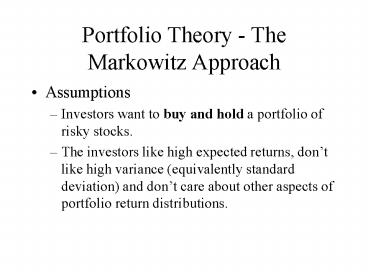Portfolio Theory The Markowitz Approach - PowerPoint PPT Presentation
1 / 24
Title:
Portfolio Theory The Markowitz Approach
Description:
Investors want to buy and hold a portfolio of risky stocks. ... sets of mean-standard deviation pairs that make an investor equally well off. ... – PowerPoint PPT presentation
Number of Views:830
Avg rating:3.0/5.0
Title: Portfolio Theory The Markowitz Approach
1
Portfolio Theory - The Markowitz Approach
- Assumptions
- Investors want to buy and hold a portfolio of
risky stocks. - The investors like high expected returns, dont
like high variance (equivalently standard
deviation) and dont care about other aspects of
portfolio return distributions.
2
Return
- In this setting, portfolio return is defined by
- End-of-period wealth - Beginning-of-period
wealth - Beginning-of-period wealth
3
Example
- The only tricky part about applying this
definition occurs when some short positions are
involved - What is the realized portfolio return if you
invested 100 in the TSE 300 last year by
borrowing 20 at 5 per year and used 80 in
cash? Assume that the 100 invested in the TSE
300 has now grown to 110.
4
The Mean-Variance Tradeoff
- In the absence of arbitrage opportunities, the
set of returns from all securities gives rise to
an efficient frontier. - The efficient frontier bounds the tradeoffs that
are available between mean and variance by
trading in all securities.
5
Mean-Variance Analysis
Efficient mean/ std. dev. tradeoffs
All possible mean/std. dev. tradeoffs
6
Mean-Variance Analysis
7
Utility
- Investors are typically thought of as being risk
averse - When given the choice between
- a) a riskless payment of 10 and
- b) a 50/50 chance of 20 or 0
- most people choose a).
- This is a consequence of diminishing marginal
utility of wealth.
8
Diminishing Marginal Utility
Utility
Low Marginal Utility
High Marginal Utility
Wealth
9
Indifference Curves
- If investors have utility functions of a special
type, they only care about mean and variance. - Indifference curves define sets of mean-standard
deviation pairs that make an investor equally
well off.
10
Indifference Curves
Mean
Higher Utility
Indifference Curves
Standard Deviation
11
Combining Utility Theory and Mean-Variance Theory
12
Mean-Variance Analysis
- Properties of MV frontier
- Higher mean returns can only be achieved by
increasing portfolio variance. - More risk-tolerant investors will choose higher
variance portfolios but receive higher expected
returns. - These efficient portfolios can be calculated if
we know the covariance matrix. - There are companies who will calculate return
covariances for you (e.g. BARRA)
13
Portfolio Separation
- An important result
- all efficient portfolios are a combination of the
same two efficient portfolios! - Implication
- If there were no information issues and investors
cared only about mean and variance, only two
mutual funds would be required to satisfy all
investors stock market demands.
14
Mean-Variance Analysis
15
Risk-free Borrowing and Lending
- You can expand the efficient set if risk-free
borrowing and lending are possible. - If you invest X in t-bills and (1-X) in an
efficient portfolio the mean and variance of the
portfolio are
16
(No Transcript)
17
Efficient Set
Tangency portfolio
18
Portfolio Separation
- If there were no information issues and investors
cared only about mean and variance, only t-bills
and one mutual fund (the tangency portfolio)
would be required to satisfy all investors stock
market demands. - Investments in this tangency portfolio and
t-bills dominate all other investments!
19
The Market Model
- The market model expresses all returns in terms
of the market return and some extra noise.
20
The Market Model
Stock Return
0
Index Return
0
21
Implications of Market Model
- Slope measures covariance of stock and index
returns - Stock risk is market risk plus unique risk
22
Implications of Market Model
- Portfolio Beta is the weighted average of the
individual stock Betas
23
The Market Model
- The unique risk of a well-diversified portfolio
is zero
24
Decomposition of Stock Variance































